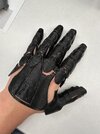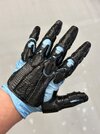Howdy kids! Thought I'd post on here and search the minds of those who know 3D modelling better than I.
Working on my current Mk VII build, and I'm really looking to elevate what I can do costume wise. One of the things I've been wanting to implement the most is highly-detailed. I've been using InstinctCreative's files from Etsy, and the detail is absolutely fantastic. The challenge currently is bringing them into the physical world.
Here's what I've tried thus far, and what I've learned:
3D Printing!
Obviously my first love, and the method I'm most comfortable with. Started with TPU that has a shore hardness of 92A, is not nearly flexible enough to really be usable for this (its more akin to the material a shopping cart wheel is made of). Working my way down to more flexible filaments, but the lowest I can find is 60-75A, which is SUBSTANTIALLY more expensive, harder to use, and STILL not a guarantee that it'll end up soft enough.
Image is PRILINE TPU, which is kinda my go-to for TPU stuffs. Definitely too hard for this tho (1 wall, 5% infil)
 Silicone!
Silicone!
This is a cool one that I'm just starting to dip my toes into. Had pretty decent success with this over the past year, certainly learned a lot, and ended up getting some pretty decent results from it! This would be my new focus if not for two issues; the cost and the MESS. Not sure if anyone else has found cheaper silicone to be used, but most of what I'm finding is proving to be pretty pricey (Dragonskin silicone is like 40 bucks for their pint size). Considering going down this route would lead to more full body silicone stuff, I'd definitely need to find a more economical brand. Second is obviously how messy it is. As I don't currently have a garage, all the silicone work would have to be within my apartment (or in the parking lot ). Obviously not ideal.
). Obviously not ideal.
However, the drip can't be denied.
 Printed Pattern?!
Printed Pattern?!
Here's a new thought that I want to get some other brains on. Since 3D printing on top of fabric is possible (tricky, but possible), I'm wondering if it would be possible to take a 3D model, flatten it out and slice it to match up with a glove pattern such as this one.

I want to find out if there's a way to take this 3D glove model, flatten it to almost a texture (keeping the different armored raises) and using THAT as a pattern to 3D print onto some cloth. Then it would just need sewing together, theoretically. Obviously this comes with it's own issues, but if it's actually possible/successful, this may be an awesome way to make cosplay soft parts for cheap, and with a relative amount of ease.
If anyone out there with more 3D modelling experience has got any wisdom or opinions on this, let me know! Still experimenting with the other options as well, will update on any findings I come across. Next update will probably be with softer TPU/TPE.
-052
Working on my current Mk VII build, and I'm really looking to elevate what I can do costume wise. One of the things I've been wanting to implement the most is highly-detailed. I've been using InstinctCreative's files from Etsy, and the detail is absolutely fantastic. The challenge currently is bringing them into the physical world.
Here's what I've tried thus far, and what I've learned:
3D Printing!
Obviously my first love, and the method I'm most comfortable with. Started with TPU that has a shore hardness of 92A, is not nearly flexible enough to really be usable for this (its more akin to the material a shopping cart wheel is made of). Working my way down to more flexible filaments, but the lowest I can find is 60-75A, which is SUBSTANTIALLY more expensive, harder to use, and STILL not a guarantee that it'll end up soft enough.
Image is PRILINE TPU, which is kinda my go-to for TPU stuffs. Definitely too hard for this tho (1 wall, 5% infil)
This is a cool one that I'm just starting to dip my toes into. Had pretty decent success with this over the past year, certainly learned a lot, and ended up getting some pretty decent results from it! This would be my new focus if not for two issues; the cost and the MESS. Not sure if anyone else has found cheaper silicone to be used, but most of what I'm finding is proving to be pretty pricey (Dragonskin silicone is like 40 bucks for their pint size). Considering going down this route would lead to more full body silicone stuff, I'd definitely need to find a more economical brand. Second is obviously how messy it is. As I don't currently have a garage, all the silicone work would have to be within my apartment (or in the parking lot
However, the drip can't be denied.
Here's a new thought that I want to get some other brains on. Since 3D printing on top of fabric is possible (tricky, but possible), I'm wondering if it would be possible to take a 3D model, flatten it out and slice it to match up with a glove pattern such as this one.
I want to find out if there's a way to take this 3D glove model, flatten it to almost a texture (keeping the different armored raises) and using THAT as a pattern to 3D print onto some cloth. Then it would just need sewing together, theoretically. Obviously this comes with it's own issues, but if it's actually possible/successful, this may be an awesome way to make cosplay soft parts for cheap, and with a relative amount of ease.
If anyone out there with more 3D modelling experience has got any wisdom or opinions on this, let me know! Still experimenting with the other options as well, will update on any findings I come across. Next update will probably be with softer TPU/TPE.
-052






